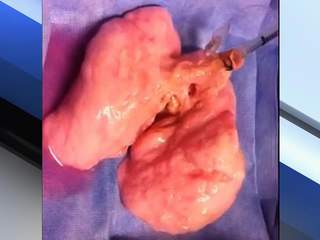L
LequteMan
Guest
Scientists have for the first time in history created human lungs in a lab, an exciting step forward in regenerative medicine, but an advance that likely won't help patients for many years.
If the lungs work, and that's a big if, they could help the more than 1,600 people awaiting a lung transplant. Lungs are one of many body parts being manufactured in the lab, some parts, such as tracheas and livers, are even further along.
The researchers in Galveston, Texas, started with lungs from two children who'd died from trauma, most likely a car accident, Nichols said. Their lungs were too damaged to be used for transplantation, but they did have some healthy tissue.
They took one of the lungs and stripped away nearly everything, leaving a scaffolding of collagen and elastin.
The scientists then took cells from the other lung and put them on the scaffolding. They immersed the structure in a large chamber filled with a liquid "resembling Kool-Aid," Nichols said, which provided nutrients for the cells to grow. After about four weeks, an engineered human lung emerged.
Repeating the process, they created another lung from two other children who'd died.
The lab-made lungs look very much like the real thing, just pinker, softer and less dense, Joan Nichols, a researcher at the University of Texas Medical Branch.said.
Nichols said she thinks it will be another 12 years or so until they'll be ready to try using these lungs for transplants.
"My students will be doing the work when I'm old and retired and can't hold a pipette anymore," she said.
Before researchers experiment on humans, they'll try out lab-made lungs on pigs, she said.

If the lungs work, and that's a big if, they could help the more than 1,600 people awaiting a lung transplant. Lungs are one of many body parts being manufactured in the lab, some parts, such as tracheas and livers, are even further along.
The researchers in Galveston, Texas, started with lungs from two children who'd died from trauma, most likely a car accident, Nichols said. Their lungs were too damaged to be used for transplantation, but they did have some healthy tissue.
They took one of the lungs and stripped away nearly everything, leaving a scaffolding of collagen and elastin.
The scientists then took cells from the other lung and put them on the scaffolding. They immersed the structure in a large chamber filled with a liquid "resembling Kool-Aid," Nichols said, which provided nutrients for the cells to grow. After about four weeks, an engineered human lung emerged.
Repeating the process, they created another lung from two other children who'd died.
The lab-made lungs look very much like the real thing, just pinker, softer and less dense, Joan Nichols, a researcher at the University of Texas Medical Branch.said.
Nichols said she thinks it will be another 12 years or so until they'll be ready to try using these lungs for transplants.
"My students will be doing the work when I'm old and retired and can't hold a pipette anymore," she said.
Before researchers experiment on humans, they'll try out lab-made lungs on pigs, she said.


